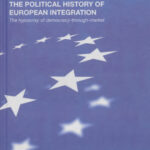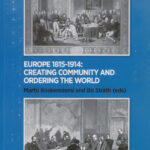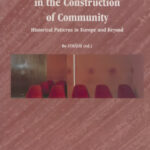De förenade rikena Sverige och Norge 1814-1905

Union och demokrati. De Förenade rikena Sverige-Norge 1814-1905 (Union and Democracy. The United Kingdoms Sweden-Norway 1814-1905). Nora: Nya Doxa 2005. 734 pp. Ill. Norwegian translation Union og demokrati. Dei sameinte rika Sverige-Noreg 1814-1905. Oslo: Pax 2005


Anniversaries provoke jubilee publications and exhibitions as well as public reflection on past triumphs or losses. Historians are requested, and governments and research sponsors are prepared to fund such celebrations. The separation of the United Kingdoms of Sweden and Norway in 1905 made 2005 a year of this kind, United Kingdoms in the plural as opposed to the UK. In the early 1990s, more than ten years before the event, Stråth participated in a conference at Voksenåsen in the mountains above Oslo. The meeting was a kind of opening towards a book project by Norwegian economy historian Francis Sejersted and Swedish historian Göran B Nilsson. The latter would write about the short Union century (1814-1905), the former about the century that followed in two monographs. Stråth remembers how he participated in the discussion at the meeting without precisely remembering what he said. After the meeting, the issue disappeared from his horizon. In Florence, in the early 2000s, Stråth got a call asking whether he could imagine taking over the writing of the union volume since Nilsson reported that he felt that he couldn’t fulfil his task. After considering the offer and solving some practical questions, such as leave for 2 1/2 years from the EUI chair, although with maintained employment conditions, Stråth accepted. The cooperation with Francis Sejersted was both intellectually and personally very rich and rewarding. In many discussions with him in person and online, the contours of the monograph took form. Early on, it became clear that democracy was the issue that brought up the Union (see the abstract below). In both countries, the more democratic and politically radical Norway and the more conservative and aristocratic, less democratic Sweden, the respective national projects, although very different, looked more promising. The discussions between Sejersted and Stråth, and Stråth’s volume, connected the Union’s problem with democracy to the ongoing European debate on the same issue, a Europen confederation or federation. The Dutch and French referendums turned down the proposed European Constitution, as we know. The year was 2005. There was scope for comparative reflection. Sejersted’s intellectual curiosity and interest in alternatives in historical processes drove his interest in the Swedish-Norwegian Union. How would Norden have looked like a century after 1905 if the Union hadn’t been undone? Such questions amused him intellectually but didn’t mean that he regretted its failure or wanted another history. But as an intellectual’s reflection on alternatives in history… Sejersted had researched and written vastly about democracy and economic development in Norway, such as his book Demokratisk kapitalisme (1993), and shared with generosity from his vast knowledge, which made Jürgen Habermas get in touch with him to hear more about whether Norway wasn’t the case that empirically confirmed his thesis about the structural transformation of the public sphere, a thesis that influential voices argued suffered from lack of historical realism and was just an idea. Stråth enjoyed and benefited from the reflections with Sejersted beyond the immediate book project and was sad when he departed in 2015.
Abstract
The union between Sweden and Norway was established in 1814 through military conquest during the turbulence of the Napoleonic wars. The union was liquidated in 1905 through what in Norway was seen as the king’s abdication and in Sweden as a Norwegian coup d’état. After negotiations, the separation occurred peacefully.
The union between Sweden and Norway was a matter of combining union with nation, constitution and, towards the end of the 19th century, the demands for democracy. This was primarily the king´s problem since he was the unifying link in the union. The theme that ran through the history of the union is the question of to what extent he succeeded in this task. This question is complicated because the king, as a unifying force, was not one but two kings. He was not formally the Union king, even though he was often called that, but the King of Sweden and the King of Norway. The definition of the royal power that lay in this subtle distinction led to equilibristic operations and acrobatic exercises that easily resulted in a kind of royal schizophrenia.
Owing to a series of recurrent crises, there was a gradual transition from a royal foreign policy to a democratic, constitutional one. The Union´s problem was that popular power was formulated via Norwegian and Swedish nationalism rather than as a demand for a democratic union. From the 1840s, the two nationalisms, together with Scandinavianism, which created the idea of a Scandinavian union, developed a complex and explosive ideological pattern nourished by the king´s foreign policy. In the 1890s, the public media in which these ideologies were formulated had become more widespread and united, and nationalism was an increasingly difficult force to tame. The kings had whipped it up and ridden on it in foreign political activism in the 1850s and 1860s. A certain degree of stability came in the wake of the establishment of German power after 1870, but the crisis of liberalism with the breakdown of free trade and the markets and protectionist policies after the middle of the 1880s reawakened the nationalistic language. In the 1890s, the king lost his grasp on this rhetoric. He found it increasingly difficult to keep apart the distinction between being the Norwegian and the Swedish king. The breakthrough of protectionism in Sweden broke down the free trade arrangement between the two countries, which was one of the institutional pillars of the union. The protectionist politics were formulated in a chauvinistic and offensive nationalistic language, conveying that Norway was a tributary people under Swedish supremacy. This triggered a nationalistic Norwegian debate with claims for full autonomy within or, if necessary, without the union.
To help him bridge the gap between the two crowns, the king had the combined ministerial council, a common government for common matters. However, this was the embryo of a union government in the real meaning of the term, an embryo that was never realised. In the transition from royal power to people´s power in the 19th century, the governments and the combined ministerial council were torn between two principles and two centres of power: the king´s constitutional power and the parliamentary people´s power. Here, the exact definition of royal and people’s power was highly controversial. The combined ministerial council was eventually torn apart in this struggle, and the national governments and parliaments were strengthened.
The Union´s problem was that popular power was formulated via Norwegian and Swedish nationalism rather than as a demand for a democratic union. The limits of the union were reached with the demands for democracy. In Norway, democratic claims were embedded in a nationalistic language which described the Norwegian king as a foreign ruler. Neither party was able to develop any union institutions to meet what, in modern terms, was increasingly thought of as a democratic deficit. The king stood almost alone as a unifying institution, and the powers that demanded political reform were too much for him. The demands for democracy were channelled towards national centres of power and broke up the union.
The book on the union was one part of a book project with Francis Sejersted, who wrote a volume on the relations between Sweden and Norway and their domestic developments during the century after the dissolution in 2005. Riksbankens Jubileusfond, Stockholm financed the project.




































